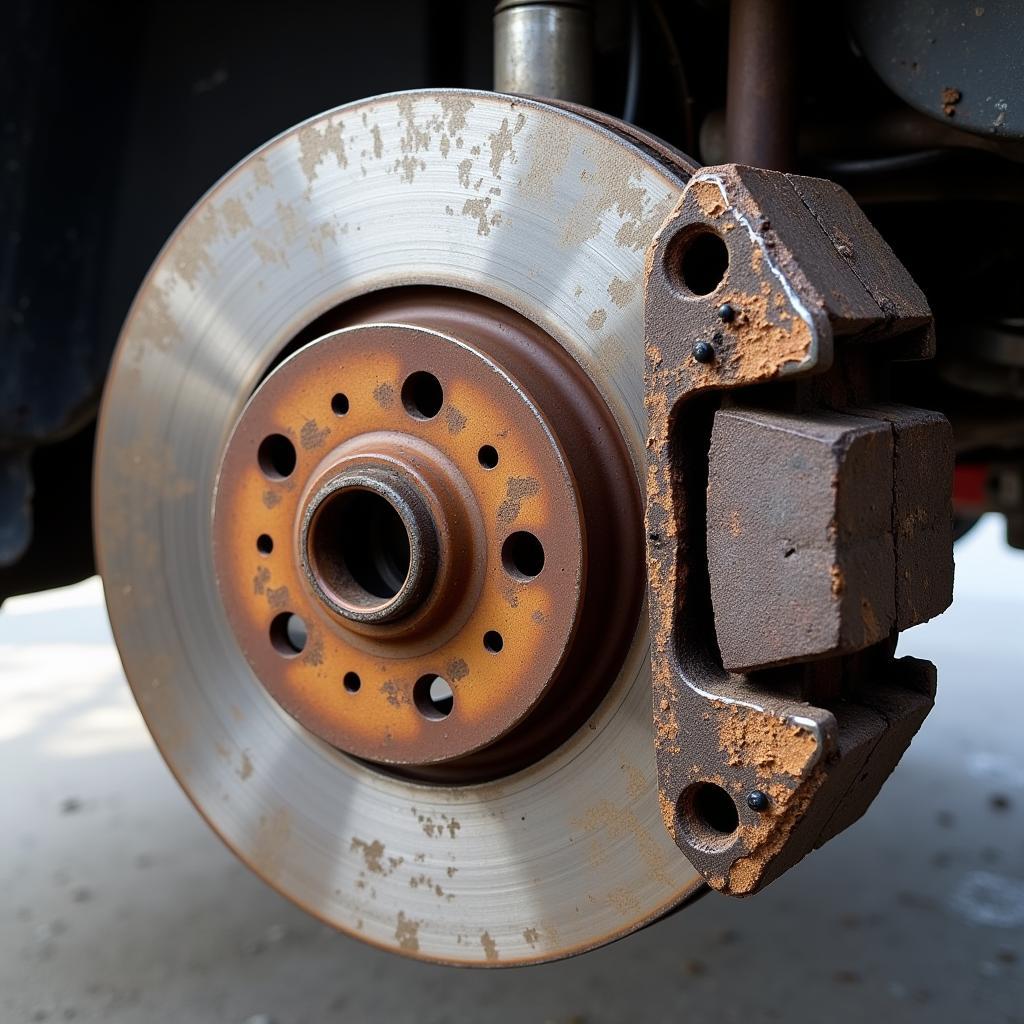Car brakes are arguably the most important safety feature in your vehicle. Problems With Car Brakes can range from annoying squeaks to complete brake failure, putting you and others at risk. Understanding the common issues, their causes, and potential solutions can empower you to address these problems effectively. This guide provides valuable insights into troubleshooting and repairing various car brake problems.
 Worn Brake Pads and Rotors Causing Brake Problems
Worn Brake Pads and Rotors Causing Brake Problems
Common Brake Problems and Their Causes
Brake problems manifest in various ways, from subtle changes in performance to alarming noises. Recognizing these symptoms is crucial for timely diagnosis and repair.
Squeaking or Squealing Brakes
A high-pitched squeal or squeak is often the first sign of worn brake pads. The small metal indicator tabs on the brake pads contact the rotor, creating the noise to alert you that replacement is needed. However, squeaking can also be caused by dust, debris, or moisture between the pads and rotors. Sometimes, glazed brake pads can also produce a squealing sound.
Grinding Noise When Braking
A grinding noise is more serious and usually indicates that the brake pads have worn down completely, allowing metal-to-metal contact between the backing plate and the rotor. This can cause significant damage to the rotors, requiring costly repairs. Continuing to drive with grinding brakes can be extremely dangerous.
Soft Brake Pedal
A soft or spongy brake pedal suggests a problem with the brake hydraulic system. This could be due to air in the brake lines, a leak in the brake lines or hoses, or a failing master cylinder. A soft brake pedal requires immediate attention as it significantly reduces braking effectiveness.
Pulsating Brake Pedal
A pulsating brake pedal, especially when braking at higher speeds, often indicates warped brake rotors. Rotors can warp due to excessive heat buildup from hard braking or uneven cooling. Warped rotors can also cause vibrations in the steering wheel.
Diagnosing and Fixing Brake Problems
While some brake problems, like worn brake pads, can be relatively easy to diagnose and fix, others require specialized tools and expertise.
Checking Brake Pads
Inspecting your brake pads is a straightforward process. You can usually see the brake pads through the spaces in the wheels. If the pad material is less than ¼ inch thick, it’s time for a replacement. If you’re uncomfortable doing this yourself, a qualified mechanic can inspect your brakes.
Bleeding the Brakes
Air in the brake lines can cause a soft brake pedal. Bleeding the brakes involves removing the air from the hydraulic system. This procedure requires specific tools and knowledge, and it’s often best left to a professional.
Replacing Brake Rotors
Warped or damaged rotors need to be replaced or resurfaced. Resurfacing involves machining the rotor surface to restore its smoothness. However, if the rotors are too thin, they must be replaced.
Repairing Brake Lines
Leaking brake lines are a serious safety hazard. Damaged brake lines need to be replaced promptly. This repair involves working with the brake hydraulic system and should be handled by a qualified mechanic.
Preventing Brake Problems
Regular maintenance is key to preventing brake problems.
- Regular Brake Inspections: Have your brakes inspected at least once a year or as recommended in your car’s owner’s manual. Early detection of potential problems can save you money and ensure your safety.
- Brake Fluid Flush: Brake fluid absorbs moisture over time, which can reduce its effectiveness. Regularly flushing the brake fluid, typically every two to three years, helps maintain optimal braking performance.
- Avoid Hard Braking: Excessive hard braking can contribute to rotor warping and premature wear of brake pads. Anticipate stops and brake smoothly whenever possible.
“Regular maintenance is the key to a healthy braking system,” says John Smith, a certified automotive technician with over 20 years of experience. “Catching issues early can prevent more extensive and costly repairs down the road.”
Common car problems, like those related to the Toyota Highlander Hybrid’s braking system, can often be prevented with proactive maintenance. You can find more information on common car problems toyota highlander hybrid. If you suspect issues with your car’s cross joint, check out our article on car cross joint problem.
Conclusion
Problems with car brakes should never be ignored. From minor squeaks to major malfunctions, understanding the signs and causes of brake problems is crucial for maintaining your safety on the road. Regular maintenance and timely repairs are essential for ensuring optimal braking performance and preventing costly damage.
“Addressing brake issues promptly is paramount for your safety,” adds Jane Doe, another experienced automotive technician. “Don’t hesitate to consult a qualified mechanic if you experience any unusual brake behavior.” If you’re interested in electric cars and their range capabilities, you might want to check out our article on range problems with electric cars 2017. For issues related to your car’s A/C, we’ve compiled common problems in our article on common a/c problems in cars. If you’re a gamer and enjoy math challenges, check out our racing car games math problems.
Connect with AutoTipPro for further assistance or personalized advice regarding your car brake problems. Our team of experts is here to help. Contact us at +1 (641) 206-8880 or visit our office at 500 N St Mary’s St, San Antonio, TX 78205, United States.




Leave a Reply